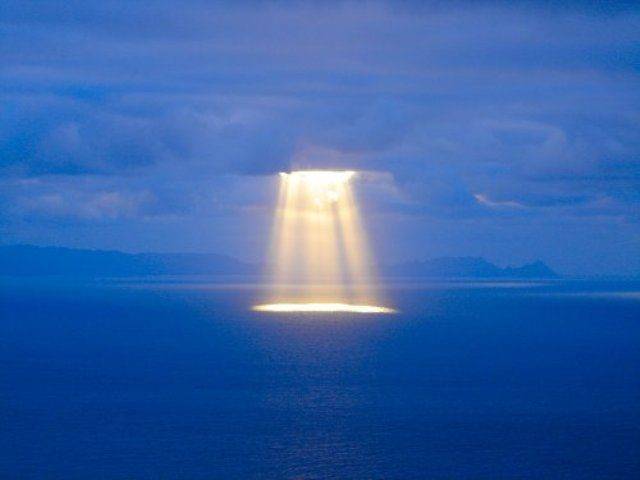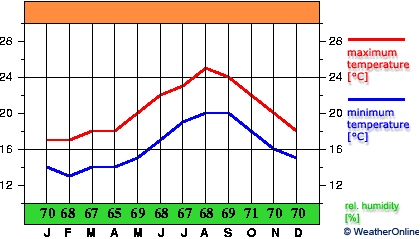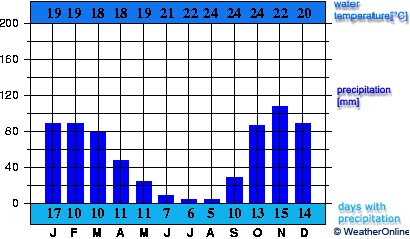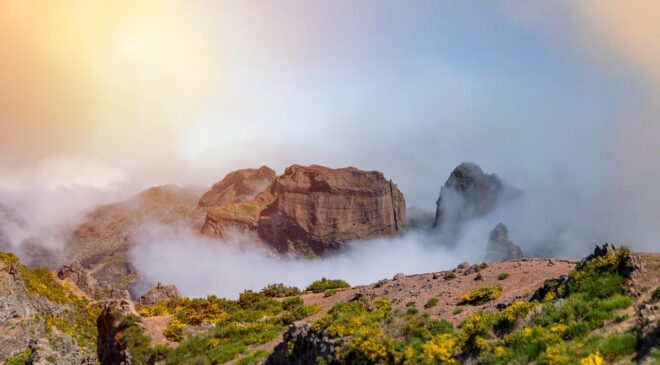Weather in Madeira
The weather in Madeira varies a lot depending on the time of year. The island experiences four seasons: Summer, Autumn and Winter. Here’s an overview of what you can expect in each. If you’re planning a trip to Madeira during a specific season, you should consider the climate and activities you plan to do.
Summer
The warmest time of year to visit Madeira is in the summer months, from June to August. Temperatures in Funchal reach up to 22degC during the day and drop to around 16degC at night. Although the island is usually not as hot as other parts of Europe, it is still warm enough for sunbathing and swimming. During the summer, the island is also much busier, and prices tend to increase. This time of year also marks the beginning of the Flower Festival, which lasts for four weeks after Easter, culminating in a carnival celebration.
Autumn is a pleasant time to visit Madeira. The weather remains warm and dry, with fewer showers than in summer. On average, there are nine hours of sunshine each day. Temperatures in winter drop to a chilly 4degC, but the climate is still very pleasant. There are plenty of opportunities to explore the island’s natural treasures during the autumn months.
For nature lovers, Madeira is also home to many lush gardens and forests. Its diverse bioclimate allows it to support a wide variety of exotic plants. The Monte Palace Tropical Garden has over 100,000 species of plants, while the Parque Forestal de Queimadas boasts a stunning laurel forest. Visitors to the Palheiro Gardens can also marvel at the famous camellia collection. Finally, the Vereda dos Balcoes forest is full of endemic species.

Autumn
The weather in Madeira varies from season to season, but the island has a mild climate throughout the year. While the island is hot and dry during summer, the island has a milder climate in the autumn. In October, temperatures remain comfortable at around 22 degrees C. The island is a great place to visit during autumn if you want to avoid the crowds and enjoy some peaceful time.
The average temperature is 22.7 degC (72.9°F). Light clothing is appropriate for the colder weather. Light sweaters and long trousers are useful. While the island is still warm and sunny during October, it is chilly at night. If you’re a beach lover, this isn’t the time to visit, as temperatures will be lower than other months.
The island experiences warm days in autumn, but the rainy season isn’t nearly as severe as it is in summer. Rain rarely persists for more than seven days. The temperature is usually around 23 degC during the day and 17 degC at night. In autumn, temperatures can drop to four degrees at night.
Winter
While the island’s climate is unpredictably less sunny in winter than in summer, the island still has many benefits. The weather is often better than back home, and it is much cheaper to visit during the winter months. You can expect to save as much as 40% on your holiday compared to the summer months. During the winter months, you can plan day trips and other activities, but it can also be a good time to just relax at your hotel.
You will still be able to enjoy the beaches in Madeira during the winter months. The beaches are less crowded and more tranquil during these months, making them the ideal time for a winter getaway. It’s easy to find cheap accommodations here, and the island never sleeps. It’s also worth considering the island’s scenic parks and affordable accommodations.
Although the winter months are wetter than summer, temperatures remain comfortable year-round, averaging sixteen degrees Celsius in July and August. The island’s tropical vegetation and abundant precipitation make for a pleasantly mild climate. In addition, the island’s weather varies from place to place, with the northern part of the island enjoying cooler and wetter weather. On the other hand, the southern part enjoys warmer temperatures and more sunshine.

Spring
Spring weather in Madeira can vary wildly depending on the time of year you visit. The average temperature is around 22°C in March and April, and it can get hotter. From June to October, the island is often affected by the hot, dry wind from the Sahara, which can bring high temperatures and fine red dust. However, these temperatures are not as extreme as they are on southern European islands. In addition, the island can be crowded during the spring peak season, when the island celebrates the Flower Festival, which lasts four weeks after Easter. The festival culminates in a colourful carnival celebration, which is a popular activity for visitors.
Springtime in Madeira can be very pleasant, with a gradual increase in the number of sunny days and short, wet days. Typically, the amount of overcast or mostly cloudy days decreases over the season, with only 3% of days in the middle of the month being overcast. On the other hand, the amount of days with rain and snowfall decreases steadily.
In addition to being pleasant for outdoor activities, the island’s warm, dry climate makes it ideal for water-based activities. Many tourists choose to go scuba diving or boating while on Madeira, and there are plenty of other fun options for water-based adventures on the island.
Early spring
Early spring in Madeira is one of the most pleasant times of the year to visit the island. The temperature averages in the low twenties, and the island is covered in lush greenery. In addition, the Atlantic keeps the temperature comfortable, while rainfall is minimal. On average, there are only four days of significant precipitation during this time of year.
The transition period between the rainy and dry seasons begins in April. The first half of the month is wet, with high chances of thunderstorms, but the rain falls less frequently closer to the end of the month. Temperatures in Funchal remain about the same as those in March, but in northern areas, the north-east trade winds make the weather more windy. This means that you may need to bring more warm clothing, especially for hiking.
The climate in Madeira is subtropical. As a result, the island enjoys flowering plants throughout the year. The English brought tropical and subtropical plants to the island, and these quickly became a part of the landscape.

Rainy season
The rainy season in Madeira is very short, with the most rain occurring in September. The temperature in this island is around a mild +12 to +15 deg S. In September, it is safe to swim, but the water temperature needs to be at least 18 degrees C. In October, the weather cools off with some fogs, but the temperatures remain pleasant.
The air temperature in Madeira in January is comfortable – around 18 to 20 degrees S, and the water temperature is around the same. The temperature in the ocean is around 18 to 19 degrees S. This makes for a pleasant holiday in Madeira. Although there are frequent showers and strong gusts of wind, you can still enjoy the beaches, or take a day trip to the island.
The hottest month of the year is July. In July, the temperature is around +25 deg S, with the ocean water temperatures around +24 deg W. During this month, there is also a sea breeze, which keeps the ocean temperature cool and the temperature of the air close to the coast comfortable. The rain in July is short, and the temperature in the ocean is a pleasant +24 deg C.
Off-season
The sub-tropical climate of Madeira is ideal for tourism, as the island enjoys warm temperatures and sunny days throughout the year. The hottest month is August, with temperatures reaching as high as 26C. Cooler months include February and June, with temperatures hovering around 18C or 14C. The most rainy month is September, with 36mm of rain falling in three days.
During the summer months, Madeira is hot and crowded. If you’re looking for better waves and fewer tourists, consider going in the fall or winter. The fall weather is ideal for hiking, trekking, and other outdoor activities. Fall is a great time to see the island’s blooming flowers.
February is the coolest month on the island. The average high temperature in Funchal is around 18degC (or 66degF) and the average low is around 13degC. The climate is still warm, but temperatures drop considerably during the night. A sweater or raincoat is a good idea during this time.
The winter months in Madeira are also great for vacationing. Although the island’s climate is a little cooler than the UK, there are still plenty of things to do and see in the colder months. The rainy season usually lasts from mid-October to mid-April. There’s a higher chance of rain showers and overcast days during this time. Still, the average temperature will remain comfortable throughout the winter months. If the weather is not too bad, you can go on day trips or relax in the hotel.
The island is full of diverse microclimates
The bay of Funchal, protected by the highest peaks, enjoys the best sunshine. Further down the west coast at Ponta do Sol and Calheta, backed by the lower hills of the Paúl da Serra, the sun shines brighter during the summer months, but these areas are less protected from the sea winds.
The prevailing wind is the North Easterly Trade wind that gathers off the Portuguese coast and runs down to the Cape Verde Islands. It brings moisture and large sea swells to the north coast, and often, particularly in the morning, adversely affects the weather on the eastern end of the island between Caniço and Caniçal. However, a westerly wind in these areas can be surprisingly dry and sunny, while the southern and western coasts are duly soaked.
So now back to where we started.
Madeira has lots of sun and a fair bit of rain.
If you want undiluted sun (plus the tranquil features of a lunar landscape) then anything from Cairo to Lanzarotte should just about suit. Those with more mature tastes should opt for paradise.
The climate of Madeira is subtropical
The climate of Madeira is subtropical and mild, with summer months from July to October being quite warm. The coldest months are November and January, while the sea is mildly cool throughout the entire year. The gulf stream influences the island’s climate, as it passes just north of the Tropic of Cancer.
Although Madeira is subtropical, the island does get snow on occasion. The last snowfall occurred on the island in 2021. In the snowy season, many travellers hiked the mountains. One of the most popular mountains was Pico Do Arieiro. Even though Madeira has a subtropical climate, it has many microclimates and it can be difficult to predict the weather for the entire island.
The climate in Madeira varies greatly from part of the island to the other. The island’s weather is most pleasant in Funchal, which is on the south side. The island’s central mountains provide cool conditions, while the southern lowlands have warm and sunny days. During the winter months, temperatures in Funchal can dip below zero.
Madeira is a volcanic island that is also a tourist destination. It is home to a number of endemic plant and animal species. The island used to be covered in subtropical rainforest, but the original settlers burned the island’s forests to make way for farming. The remaining forests, known as laurisilva forests, have been designated by UNESCO as World Heritage Sites and are believed to have existed on Madeira for 1.8 million years.
It is one of the warmest places in Europe in winter
The island of Madeira, Portugal, is one of the warmest places in Europe during the winter months. The island’s subtropical climate is perfect for tourists who want to escape the cold climate in winter. In addition to beautiful beaches, Madeira is also known for its lively nightlife and delicious food. The island is also home to several winter festivals dedicated to music.
The Spanish island of Tenerife is also an excellent place to visit during winter. The island is easy to reach from many places in Europe and flights are inexpensive. The island is home to many sandy beaches and stunning views of the sea and cliffs. A visit to the island is worth it, even in the winter, when temperatures can dip below zero.
Winters on Madeira are mild, making it an ideal place to go hiking. There are many trails for different levels of fitness and skill. The weather is ideal for hiking and trekking. Moreover, the island’s cuisine is typically Mediterranean and uses fresh ingredients. A popular dish is the Espetada steak, which is served with the island’s local bread, the Bolo do caco.
During the winter months, the temperatures are mild, ranging from 14 to 16 degrees. The island is home to a number of beaches and cliff-top villages. It is also known for its Christmas village, which is filled with festive decorations and local treats. The island is also home to various music concerts throughout the year.
It is rainy most of the year
The climate on Madeira is generally mild and pleasant throughout the year thanks to the warm flows of the Atlantic Ocean. The island is warm in the summer and dry in the winter, with the occasional heavy downpour. Temperatures on the island rarely fall below 17 degrees. The island also has micro-climates that differ according to the location, with the capital, Funchal, being sunny and dry while the northern and eastern parts of the island are drier and colder.
The island’s climate makes it pleasant for tourists all year round, with temperatures ranging from 18 degrees to 20 degrees. The island receives a relatively high amount of sunshine, with about five hours of sunshine per day during the winter months. Spring and autumn are also pleasant months, though rainfall and storms are more likely in these months. Visiting during this time will ensure you avoid the peak tourist season and experience a less crowded island.
The annual rainfall on Madeira Island varies depending on the altitude. The northern coast experiences the highest rainfall, while the southern coast receives the least. The rainy season lasts from July to November.
It is mild
The climate on Madeira is mild and semi-tropical. The prevailing winds blow from the northeast and last about nine months of the year. According to Dr. Grabham’s observations, there were 263 days with N.E. wind, which produces the best weather. During the winter, however, wind from the west and S.W. occur intermittently, and these are precursors to warm rains.
Due to the unique climate, Madeira has a thriving real estate industry. Investors and travellers are drawn to the island for its mild climate and exceptional quality of life. Listed below are some properties for sale in Madeira. They are available for sale at a low cost. Whether you want a quiet getaway or a luxury property, you will find what you are looking for in this region.
Madeira’s climate is moderate throughout the year. The average temperature is around 25 degrees C in summer and 17 degrees Celsius in winter. The island’s climate is influenced by the Canary Current and the Gulf Stream. While the temperatures tend to be mild year-round, they do vary depending on your location. For example, the south of the island experiences warmer temperatures, while the northern part is colder and wetter.
The island is part of the Schengen area, and its climate is mild throughout the year. The island is home to a monk seal colony and many species of birds. Visitors can enjoy dolphin and whale watching in the waters around Madeira, where they can view them in their natural habitat. To do so, small boats will depart from the harbour of Funchal. Some trips even have a marine biologist accompanying them.
It has a dry season
Despite its sunny and warm weather, Madeira does experience a dry season. Although rain is not common during this season, cloudy days can make sunny days appear faint. In addition to that, Madeira has a changing landscape that creates microclimates within the island’s climate.
The island’s climate is influenced by the Gulf Stream and the Canary Current. The Gulf Stream originates in the Gulf of Mexico and travels north along the American coast. It then crosses the Atlantic Ocean as part of Atlantic drift. This warm water helps Madeira experience a temperate climate throughout the year.
While the island is usually warm and sunny during the day, there are periods when it can be quite cold. It is important to pack appropriate clothing for the temperatures in Madeira. In general, a jacket, raincoat, and sweater are recommended. The average low temperature is around 13degC, while the maximum temperature is around 19degF.
The hours of sunshine are another important factor to consider when planning your holiday. The sunshine hours in Madeira are generally highest in the month of August, while the shortest months are in December and March. Another factor to consider is wind speed. Madeira experiences more wind in the winter than in the summer.
The dry season is 6.0 months long, from April 9 to October 9. The wettest month is July, with just two days of over 0.04 inches of precipitation per day. Wet days can be rain or snow, or a combination of both. In addition, there are 5.2 days of rain alone during the month of December, with a peak probability of 18% on December 7.
Madeira climate
Funchal has a Mediterranean local weather ( Csa based on the Köppen local weather classification ) four with delicate temperatures all year long, with the annual common of 19.6 º C. Not like different cities within the south coast of Madeira to Ponta do Sol , Paul do Mar and Jardim do Mar , common temperatures within the coldest months are located roughly 1 º C underneath a classification of tropical local weather with a dry season ( based on the Köppen local weather classification ) four . Might be differentiated two distinct seasons , though no giant variations between the 2 : the primary from October to March with common rainfall and common most temperatures ranging between 25 º C in October and 20 º C in January and February and the second from April to September, with low rainfall and common most temperatures ranging between 21 º C in April and 26 ° C in August and September.
The moisture degree stays fixed round 70 %, which leads to a extra pronounced notion of warmth respect to precise temperatures . The overall rainfall in the course of the wet season varies from 12 months to 12 months. The ocean water temperature varies between 18 º C and 19 º C in February and between 24 º C and 26 º C in August and September .
Because the metropolis is in a type of amphitheater with the ocean on one aspect and mountains on the opposite ( rising to 1800 meters above sea degree ) is kind of widespread register cloudiness , rain and wind at greater altitudes whereas sky cleaner in areas alongside the coast.
In early summer time , particularly in June , is often noticed a phenomenon known as ” helmet Funchal ” the place all the town’s bay is persistently coated in clouds for days on finish .
The warm ocean currents that surround the island help dictate the climate and mean an absence of extreme temperatures. The cooling winds that brush the island also contribute to pleasant summer temperatures. Humidity is not usually a problem on the island, being fairly stable throughout the year, with averages ranging from 67% to 72%.
The island’s climate is greatly affected by the winds that prevail in the region. The main wind affecting Madeira’s climate is the northeast trade wind that blows down from the Portuguese coast. Also playing an important role is the warm wind that occasionally blows from North Africa.
In February 2010, Madeira experienced some of the most intense storms the island has ever seen, resulting in flooding and landslides. At least 32 people died and more than 100 were seriously injured in the natural disaster, due to the consequences of the heavy rains.
The dramatic rainfall was the result of an Atlantic low pressure area and an active cold front over the Azores that moved northeastward on February 19, 2010.
This combination of weather conditions resulted in a series of storms that not only affected Madeira, but also saw strong winds, flooding and rainfall hit Portugal, Spain, Morocco and the Canary Islands.
Floods and landslides across the southern half of the island were the result of the extreme rainfall. Some places received in a few hours up to double the monthly average rainfall.
Water Temperature

Climate in Madeira Island
Autumn: September, October, November
Autumn arrives gently in September, and the weather is still warm and sunny in October and November, although there is a chance of rain, with around seven days of rain, a fairly low average for this time of year when compared to other places. Average temperatures are between 23°C and 17°C, which is actually better than the English summer. Therefore, this is still a great time to come to Madeira for those who prefer a quieter experience.
Winter: December, January, February
It’s a little difficult to really talk about winter in Madeira as it’s always summer in Madeira. During these months the average temperatures only drop about 4°C. Thus, during the daytime in Funchal it’s around 20ºC and at night it’s normally above 14ºC. Thus, this thermal amplitude is particularly appealing to tourists from Northern Europe, who seek Madeira as a winter sun destination. In terms of rainfall, the average is still some seven days of rain per month in December and January, with a slight improvement to six days in February. Keep in mind that Madeira grows bananas during winter.
Spring: March, April, May
With the arrival of spring, days get longer, rainfall tends to be lower and temperatures start rising in April and May. Around this time, the whole island is in bloom, attracting more and more tourists, eager to discover the great outdoors in this sunny piece of paradise.
Summer: June, July, August
Thanks to its excellent climate, this island is particularly popular with tourists during the summer months. Temperatures average a maximum of 24°C and a minimum of 17°C, so evenings are really pleasant and it is comfortably warm during the day (although temperatures can reach around 33°C when the east wind from the Sahara Desert blows for a few days). During these months it rains very little. In fact, in July and August it may not rain at all, except high up in the mountains, and only in late September does it rain a little.
The prevailing wind is the commercial north-easterly wind that gathers off the Portuguese coast and drifts down to the Cape Verde islands. It brings moisture and large swells to the north coast and often, particularly in the morning, adversely affects the weather at the eastern end of the island between Caniço and Caniçal. However, when the westerly winds blow, these areas can be surprisingly dry and sunny, while the south and west coasts can be cloudy. Translated with www.DeepL.com/Translator (free version) Translated with www.DeepL.com/Translator (free version)
Temperature

Precipitation

More info in https://www.portugal.net/en/madeira/madeira-weather/
Webcams: https://www.meteoblue.com/en/weather/webcams/madeira_portugal_2266877
Maps: https://www.meteoblue.com/en/weather/maps/madeira_portugal_2266877#coords=4/32.67/-16.75

